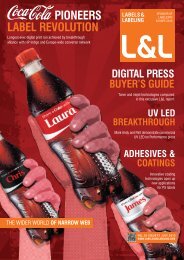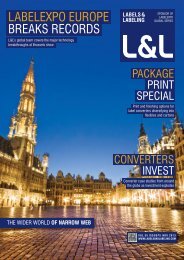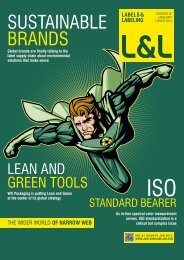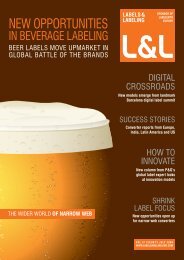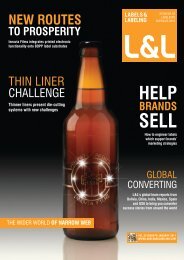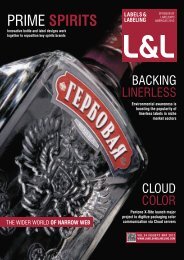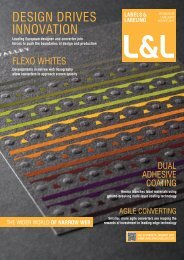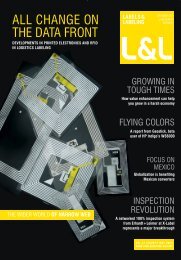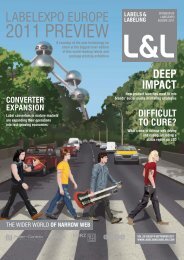You also want an ePaper? Increase the reach of your titles
YUMPU automatically turns print PDFs into web optimized ePapers that Google loves.
LABELS&LABELING |25<br />
Reducing carbon emissions<br />
in the label industry<br />
MIKE FAIRLEY looks at the challenge faced by the label industry to reduce carbon emissions and argues for<br />
more joined-up thinking, industry collaboration, and carbon footprint reduction measures for the future<br />
One of the key challenges facing the label industry today is that<br />
of reducing its carbon footprint. Pressures on the packaging<br />
and label industries to reduce carbon emissions are being<br />
driven by governments, brand owners, major retail groups<br />
and consumer organizations; more and more demands are<br />
being made for carbon footprint labeling on packaging, while<br />
packaging users are looking to significantly reduce their carbon<br />
footprint in the supply chain.<br />
In the UK for example, the Climate Change Act in 2008<br />
made the UK the first country to set out a framework for the<br />
transition to a low carbon economy – with a plan to cut carbon<br />
emissions by 80 percent by 2050, and an intermediate target of<br />
a reduction of between 26 percent and 34 percent by 2020.<br />
Many of the national and international retail groups have also<br />
set out ambitious carbon reduction plans. Tesco, one of the<br />
world’s leading retail groups, aims to slash its environmental<br />
footprint by 30 percent by 2020. Trials began a year ago to set<br />
up a supply chain collaboration hub, overseen by consultancy<br />
2degrees. Major suppliers such as Diageo and Coca-Cola have<br />
already joined the group and Tesco is now looking to get its top<br />
1,000 suppliers involved by the end of 2012.<br />
In the USA, Wal-Mart, the world’s biggest retailer and owner of<br />
Asda, has long pledged to slash its carbon footprint by barring<br />
products that contribute to global warming from its shelves and<br />
is looking to its suppliers to reduce 20 million metric tons of<br />
greenhouse gas emissions by the end of 2015. The company<br />
has already been working with suppliers in the past few years<br />
to reduce its packaging footprint.<br />
In France, the French government launched a pilot program<br />
to get multinational firms involved with carbon footprint labeling.<br />
Already companies including Unilever, Heineken and Proctor<br />
& Gamble are applying carbon labels to products. Indeed,<br />
the pilot has proved to be so popular that some companies<br />
volunteering to take part even had to be turned down.<br />
Back in the UK, Sainsbury’s supermarket is introducing new<br />
on-pack information aimed at helping shoppers make what it<br />
calls ‘more sustainable purchasing decisions.’ New packaging<br />
designs introduced by the supermarket are reported to have<br />
already generated an 11 percent reduction in packaging weight<br />
over the past two years.<br />
So how are all these initiatives impacting on the label<br />
industry? Certainly some of the leading label companies and<br />
groups have achieved significant sustainability and/or carbon<br />
reduction targets. Spear is undoubtedly a good example of this.<br />
Many of the main industry suppliers have also been working on<br />
initiatives, developing new or modified products, looking at new<br />
solutions, calculating carbon emissions, or introducing new<br />
materials. The industry has certainly moved forward over the<br />
past few years.<br />
The publication by Tarsus in September last year of the<br />
‘Environmental Performance and Sustainable Labeling’<br />
handbook to becoming a greener label converter has also<br />
helped to raise awareness and guide the industry into taking<br />
further steps towards a more sustainable future. Any label<br />
company, whatever its size, should be able to make use of this<br />
publication to good benefit.<br />
Having said that, the label industry cannot afford to rest on its<br />
laurels. The number of label converters or industry suppliers that<br />
have documented carbon footprint reduction targets is probably<br />
a small fraction of the total industry. Indeed it is perhaps difficult<br />
for the many smaller label converters to dedicate time and cost<br />
to creating and implementing such targets.<br />
SUPPLIER AND CONVERTER COLLABORATION TO OBTAIN COMPARATIVE CARBON FOOTPRINT ANALYSIS<br />
AND REDUCTION OF THE LABEL FOOTPRINT IN THE PACKAGING SUPPLY CHAIN<br />
LABEL CONVERTER<br />
LABEL CONVERTING PLANT<br />
LABEL CARBON FOOTPRINT<br />
SUSTRATE<br />
SUPPLIER<br />
INK<br />
SUPPLIER<br />
PRE-PRESS AND<br />
PLATE SUPPLIER<br />
PRESS AND ANCILLARY<br />
EQUIPMENT SUPPLIERS<br />
WASTE<br />
RECYCLER<br />
TRANSPORT<br />
SUPPLIER<br />
ALL SUPPLIERS TO PROVIDE A CARBON FOOTPRINT RATING ON THEIR PRODUCTS IN THE FUTURE<br />
JULY 2012 | L&L



